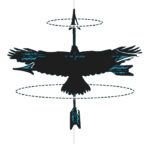I sell cheap plastic toys and make balloon animals for tips. I’m not very good. I can only make giraffes, turtles, cats, and snakes (snakes are basically just straight balloons with self-stick googly eyes). I was the first to notice the tortoise’s wounds. It looked like the tortoise stepped on some broken glass (the zoo doesn’t sell glass bottles, but people always sneak in their own booze). I told the nearest zoo employee (I’m not technically on-staff; I just rent kiosk space).
Some lab-coated woman bandaged the tortoise’s palms and gave him an injection for the pain. An hour later, the blood soaked through, and an emaciated priest started yelling “Stigmata, stigmata, stigmata!” I doubt the dude was actually ordained. But he wore the white-collar-deal, so everybody listened to his rant. He started reading from a pocket Bible, and families gathered around to glimpse the tortoise.
I never saw the priest again, but he was instrumental in starting the religious fervor. The next day, people swarmed to the area. I earned a ton of tips. I actually ran out of balloons (before that, I had never run out of balloons; it’s not like the balloon animal industry is booming). I found a rosary on the ground and pocketed it.
That night, I visited my brother in the hospital, and I told him about the tortoise. I laughed about the people who flocked to see it. But it was a half-laugh (you know, a laugh that trails off and ends in contemplation, full of guilt or self-doubt) because I envied the religious zoo patrons. And some part of me didn’t want to rule miracles out. I was pretty sure the tortoise was not divine, but I needed to remain cautiously open to the possibility. I counted the rosary beads in my pocket, and I prayed over brother’s vegetative body, skewered with ventilator hoses and dripping IVs.
After leaving the hospital, I bought some cheap drug-store toys: plush tortoise dolls, green plastic tortoises, even a few pricier ceramic tortoises (or maybe those toys were actually turtles, not tortoises; I’m not too clear on the difference). With my kiosk sitting so close to the habitat, I knew I could earn some fast cash.
The zoo manager dreamed of dollar signs too. He told the lab-coated woman to take off the tortoise’s bandages, letting everybody see the animal’s wounds. The zoo also began charging a higher fee for entry, and they let people into the habitat to touch the tortoise or pray or light candles. The faithful were so earnest. They praised the tortoise and screamed “Hallelujah!” They stood on benches and professed the ways the creature touched their lives and healed their ill.
That night, before locking up my kiosk, I stood in the tortoise line, nearly stretching to the parking lot. When it was my turn, I touched the creature’s shell and uttered a prayer. The tortoise made a weird moaning sound and retracted its head. Its wounded hands remained outstretched, covered in dried pus and blood. The stigmata looked infected, and I told a zoo employee on my way out.
I visited my brother again. The doctor told me that his heart stopped for about thirty seconds that day (the previous week, it had been ten seconds, tops). I kissed my brother’s forehead and left the rosary behind, along with a ceramic tortoise figurine.
The next day, the tortoise’s hands were still unbandaged. Goop ran from its eyes, like the infection had spread to its sinus cavity, bursting out of its skull. I told another zoo employee who shrugged it off. I told the manager who said “The tortoise is almost a hundred years old. It’s ancient. It’s sick. That’s normal.” By mid-day, the creature rolled over onto its back, just like tortoises and turtles do in cartoons. Its stubby legs twitched a moment and flicked pus onto some nearby zealots (they smeared the pus around like some grotesque blessing). The tortoise died without a sound.
The crowd gradually thinned. By nightfall, ticket prices were back to normal, the zoo’s fame completely forgotten. I locked my kiosk and made a balloon animal for the tortoise (a snake, but a good one, with perfectly placed googly eyes and Sharpie stripes on its body). I placed the balloon in front of the neglected altar (already nothing more than a mess of melted wax and discarded turtle figurines). I wiped away the pus from the tortoise’s stigmata marks. I apologized for its suffering, and I reassured the tortoise that it’d rise again in three days. It had to resurrect, otherwise my brother would never get well.
—
James R. Gapinski is managing editor of The Conium Review, and he’s associate faculty at Ashford University. “Messiah Tortoise” is the title story from his forthcoming flash collection, due out in 2017 from Red Bird Chapbooks. His work has previously appeared in Juked, Literary Orphans, Monkeybicycle, Psychopomp, SmokeLong Quarterly, Word Riot, and other publications. Find him on Twitter @jamesrgapinski.
Photo by: Ana Prundaru
